- Главная
- ООЗЖ «Эгида»
- Новости
- Каталог
- Форум
- Доска объявлений
- Энциклопедия
- Фото
- Видео
EGIDA.BY
Благотворительный портал защиты и прав животных
 Belarussian public associations for the protection of animals are hereby seeking support from the European Parliament.
Belarussian public associations for the protection of animals are hereby seeking support from the European Parliament. For many years have we been trying to make Belarus' officials understand that the current conditions for keeping pet cats and dogs, their breeding, catching, and elimination are unacceptable for a country located in the centre of Europe. There are highly educated people in Belarus for whom animal cruelty supported by government is a source of continuous moral suffering.
Belarus has no government tools for control over the breeding of pet cats and dogs.
Neither has it any radio or TV programmes which would advocate humane treatment of animals. Hatred of the strays shows through the vast majority of publications which portray the animals as an enemy, 'the root of all evil', and a major threat.
The job the government is doing to keep the number of cats and dogs under control is limited to their catching (and subsequent elimination at holding facilities), or putting them to death on the spot using any available method. The reason for the strays being killed on the spot is the violation by government officials in Belarus' towns and villages of the one and only act, which regulates animal control activities in the country. The Act is titled The Provision for the Control over the Catching, Shooting, Keeping, and Euthanasia of Homeless Animals in the Republic of Belarus. The document has been approved by the Ministry of Housing and Communal Services of the Republic of Belarus.
Under the Act, catchers' teams report to public utilities responsible for garbage collection. These are basically transport companies dealing with waste collection and transportation to dump sites. These companies do not have the funds to build animal shelters which would accept the strays and hold them for five days prescribed by law unless they are reclaimed by the owner or adopted. For instance, the Gomel region with 1,500,000 residents in 21 districts (and, respectively, 21 towns which are district centres) has only three cities which have built animal shelters, namely Gomel, Svetlogorsk, and Narowlya. This means in these three cities the strays are put to death away from the public eye. In any other place the killings happen on the streets. In small towns, catchers' teams consist of one person, a catcher by profession, a shooter, in fact. The catcher-shooter takes his gun to work every day. He shoots every animal that he comes across using dithylinum. Then, he takes the carcasses to the dump.
For example, in Turov, the Gomel region, the utilities service staff includes one catcher. The catcher shoots animals everywhere, including public places. In summer 2009, a dog wearing collars (including a flea collar) was shot dead at point-blank range at Turov market place, in front of many people, including kids. The dog belonged to the Turov market owner. She was shot only because she was banned from public places. She was shot despite the locals pleading for her life, despite any explanations of whose dog she was and why she was roaming loose at the marketplace.
In spring and summer, when cats and dogs reproduce most numerously and catchers are overworked, utilities services employ any other method to kill the strays. For example, in Novolukoml, the Vitebsk region, until summer 2009, inclusive, they used to hire the locals, including kids and teens, to collect the strays. Grown-ups, mostly those with alcohol problems, would put dogs in bags, while teens would deal with cats. The bags would be thrown into the garbage truck, taken to the waste site where they would be run over by tractors. For the first time over the many years, the desperate Novolukoml residents approached the director of the Novolukoml Town Public Utilities Service with a petition asking to name the legislative acts the public utilities were governed by when collecting and putting the animals to death. The official responsible for the collection of garbage and animals got confused and temporarily banned all activities of stray animal hunters in Novolukoml. However, it is not him who has his final say.
In fact, we don't know what's worst for Belarus' animals: being killed on the spot or being taken to quasi-shelters to wait for death experiencing fear and stress.
For example, the city of Mogilev (President Lukashenko's birthplace) has an animal shelter. The shelter belongs to Spetsavtopredpriyatie transportation company which manages waste collection and disposal. In 2008, 3,000 dogs and 1,800 cats were caught by the company's employees. Around 30 adult dogs and 100 puppies were rehomed. The cats were all put to death. No one knows which methods such shelters use to put down animals. It depends. Time was when animals would be thrown into open-air cages and starve to death forced to go without food and water as the shelter had no funds to buy food or euthanize animals. According to Nina Safontseva, the Chairperson of Mogilev Animal Welfare Association, like many other Belarusian cities and towns, Mogilev has many private houses. Their owners are the main 'suppliers' of abandoned animals. Lack of government control over the breeding of domestic animals as well as absence of laws against owners who throw their pets into the streets create a vicious circle of mass pet killings (cats and dogs). According to the 2008 statistics of the Ministry of Housing and Communal Services of the Republic of Belarus, 68,880 animals were caught in Belarus. Very few of them were rehomed.
The climate conditions in Belarus are severe, with heavy frosts and high humidity in winter. It is quite natural that in such conditions, with no food available, stray dogs can display unusually aggressive behaviour.
On 21 November 2008, Tatiana Sharayeva, a Bobruisk resident, was seriously injured in a stray dogs' attack.
Following the incident, the Prosecutor General's Office launched an inquiry into:
1. the way the legislative requirements for keeping pet dogs and cats are observed;
2. the activities of organisations involved in catching and euthanizing stray animals in Belarus.
The results of the inquiry arouse concern of Belarusian animal welfare organisations.
The first outcome was a meeting of public prosecutors from across the country held at the Prosecutor General's Office in December 2008.
Following the meeting, public prosecutors issued an instruction for public utilities officials responsible for the collection of garbage and animals to toughen animal fighting measures.
Since January 2009, animal collectors would shoot or otherwise kill every dog and cat they come across.
The shootings usually occur at daytime. Animals are shot in front of adults and kids. The photo below features cats shot with dithylinum in Bobruisk on 5 August 2009. The shootings happened near apartment blocks, schools and kindergartens. The photo of the cats' dead bodies was taken by V. Kachan, the photographer at the Bobruisk photo studio at 51 Karl Marx St., upon request by Bobruisk residents L. Karaulova, residing at 75 Minskaya St., and V. Yakovlev, residing at 30 Kirov St.
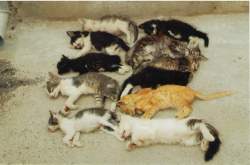
Cats die silently. Things are worse with dogs. Barks, death screams and groans can be heard.
The other outcome of the Prosecutor General's inquiry was the document the Prosecutor's Office sent to the
On Extra Measures to Prevent Damage Caused to Citizens' Health by Companion and Stray Animals.
The document and its execution have brought forward the present appeal for support of the European Parliament. Below is the Russian version of the document.
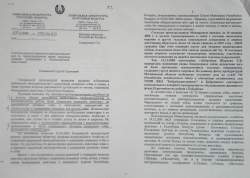
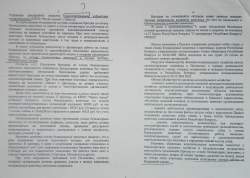

Please find below the English translation of the document part by part followed by our comments.
Paragraph 2:
| 'The inquiry has revealed that public utilities do not take sufficient preventive measures or raise awareness among pet owners, neither do they make effort to build dog playgrounds. Most playgrounds are not properly equipped or fenced so that animals can freely approach passers-by, scare them and thus present a threat to their life and health.' |
Our comment:
First of all, the conclusion of the Prosecutor General's Office about poor preventive measures among pet owners taken by public utilities staff seems weird. The sphere of public utilities' responsibility covers housing maintenance and waste collection. The employees are plumbers, foremen and janitors. What knowledge can they transmit to pet owners?
Secondly, what kind of playgrounds would have been large enough to accommodate the 68,880 animals that were caught and slaughtered in Belarus in 2008?
Paragraph 17 contains the following request by G. Vassilevich, the Prosecutor General of the Republic of Belarus:
| ''In connection with the above facts, to ensure the safety of citizens, protect their life and health, being governed by Article 27 of the Law of the Republic of Belarus On the Prosecutor General's Office of the Republic of Belarus I hereby REQUEST that: The Ministry of Housing and Communal Services be entrusted with: ■ taking effective measures to prevent pet owners from walking their dogs in violation of the Rules for keeping dogs, cats...; ■ increasing the responsibility of public utilities officials for the failure to comply with legislative requirements for dog walking and collection of stray animals. Officials shall focus on bringing more persons who violate the dog walking rules to administrative liability.' |
Below we have provided the text of the document issued by the Cabinet of Ministers of the Republic of Belarus. The document was signed by Prime Minister Sergey Sidorski on 5 January 2009. It reads: 'You are hereby requested to investigate the issue and take concrete steps.' The document also names the ministries responsible for 'taking concrete steps.' As usual, the key role belongs to the Ministry of Housing and Communal Services.
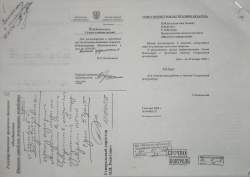
By 'taking concrete steps' the Prosecutor General's Office of the Republic of Belarus means increasing the liability of pet owners for walking their dogs off the lead and unmuzzled.
Based on the instruction of the Prosecutor General's Office, on 30 June 2009, V. Burya, the Vice Prime Minister of the Republic of Belarus approved
The ACTION PLAN for Improving the Keeping of Companion Dogs and Cats and Collection of Stray Animals.
In accordance with the Action Plan, public utilities officials (those who supervise plumbers, foremen and catchers-shooters) spent 4 months to compile proposals for increasing the responsibility of pet owners and improving the methods for the elimination of all stray animals, including those abandoned and lost.
According to the Action Plan, Belarus should now toughen its laws against pets and their owners, including increasing the responsibility of pet owners by amending the provisions of the Administrative Code of the Republic of Belarus. Upon inquiry into the dog attack on Bobruisk resident Tatiana Sharayeva, the Prosecutor General's Office established the persons to be blamed. These are pet owners who walk their dogs unmuzzled and off the lead. Now every effort has been focused on legislative amendments to increase the responsibility of pet owners.
By the way, what did the Prosecutor's Office's inquiry establish as to the uncontrolled breeding of animals due to the absence of relevant laws?
Nothing!
What did the inquiry establish as to the current methods of catching and on-the-spot elimination of animals as described above?
Paragraph 15 of the document issued by the Prosecutor General's Office reads:
| 'The examination of the catching practice has shown that some localities lack animal shelters. For instance, in Mozyr (the Gomel region), due to the lack of premises to house stray animals, all of them are put to sleep. There are no animal shelters in Baranovichi, Bobruisk, Soligorsk, Molodechno and many other places.' |
What kind of putting to sleep does this document read about? The Prosecutor General's Office is very well aware that 'putting to sleep' means killing using any available method. The best option is shooting animals using dithylinum.
The photos below feature animals being shot by a public utilities employee at one of Belarusian localities. He is officially called 'an animal catcher'. He catches animals every day. This is his job. The man is employed in the government sector of economy. He is paid for the job by the government. His salary is funded by taxpayers, including those who strongly object to such 'catching' methods.
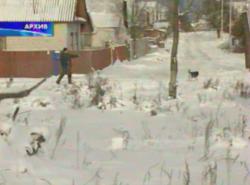
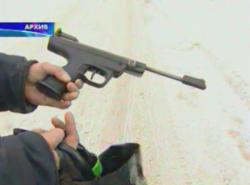
The photos have been taken from the materials of The Contours (Kontury), a weekly TV program broadcast 8:00 p.m. Sundays on the National TV Channel. The material was broadcast on 16 August 2009 in a program dedicated to the International Homeless Animals' Day.
However, not all organisations responsible for the collection of waste and animals have the money to buy guns. Therefore, the ways to kill vary, namely dogs are strangled on the spot with a loop; cats get killed by smashing their head against the tree; the animals are put in bags to be taken to the waste site and run over by tractors, etc.
Please note that the Prosecutor General's Office refers to the animals as 'stray' as they cannot be called 'caught' without being actually caught, but being killed while 'straying' throughout the country. These animals get killed even if they are straying along the street near their home.
Elena Sleptsova whose photo you can find below can tell a story about other methods of euthanasia.
Elena Sleptsova is a resident of Borovlyany village. Borovlyany is located some 10 km away from Minsk. The village territorially belongs to the Minsk district. The Minsk district has its own on-call 'catchers' team'. The team consists of two catchers - Nickolay Rudenya and his son-in-law. According to Elena Sleptsova and other Borovlyany residents, the catchers euthanize animals on the spot. Dogs are strangled with a choker loop. The bodies are then dragged to the wagon. Some dogs die while being dragged. Some suffer longer and die in the wagon. This family 'catchers' team' makes the choker loops at evenings.
The name of the dog who was saved by Elena Sleptsova is Zhuzha.
The dog found shelter at Borovlyany marketplace and lived there for about 6 months. Market watchmen loved the dog, took care of her and gave her food. From time to time, the dog would lie at Borovlyany bus stop and get food from people waiting there.
The name of the bus stop is Regional Hospital. Basically, the bus stop is a dispatching centre. People waiting at the bus stop are mainly those coming and going from the following public health institutions:
■ The Institute of Oncology
■ Minsk Regional Clinical Hospital
■ Minsk Regional Children's Clinical Hospital
■ Scientific and Practical Centre for Childhood Oncology and Haematology
■ Minsk Regional TB Dispensary.
So, on 25 August 2008, a kind shaggy dog named Zhuzha was lying under a bench at the bus stop. There were many people around, including kids.
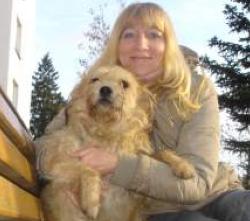 'Catcher' Nickolay Rudenya approached the dog, slipped the loop over her head, pulled it tight and started dragging the dog to his wagon which was parked some 200 m away from the bus stop. He was dragging the dog along the crowded marketplace. It was midday. Adults started screaming, kids - crying.
'Catcher' Nickolay Rudenya approached the dog, slipped the loop over her head, pulled it tight and started dragging the dog to his wagon which was parked some 200 m away from the bus stop. He was dragging the dog along the crowded marketplace. It was midday. Adults started screaming, kids - crying.
Elena says there was a woman at the bus stop with a boy with cancer going home after treatment. The boy was very thin, hairless, with bandages on. He broke down after witnessing the scene. Elena took off running after the catchers. She screamed, pleaded, begged saying that the dog was hers. She somehow managed to talk the catchers into letting her remove the loop from the dog's neck. Elena looked into the wagon. There were 7 dogs inside, all of them with loops around their necks. Some of the dogs were dead. Some were still moving.
Zhuzha lay breathless for three hours showing no signs of life. However, everyone, including Belarus' strays, has his own destiny. Today Zhuzha lives with Elena. She doesn't let the collar to be put around her neck.

 All these killings are the norm for Belarus' officials, including public prosecutors. They also believe it to be the norm that animals 'euthanized' on the spot are taken to dump sites to be left there.
All these killings are the norm for Belarus' officials, including public prosecutors. They also believe it to be the norm that animals 'euthanized' on the spot are taken to dump sites to be left there.
Below are the photos taken at one of the Belarusian landfills in November 2009. These are carcasses of the dogs shot dead by 'animal catchers'. All dump sites across Belarus are filled up with such dead bodies.
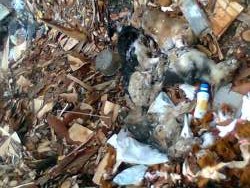
However, no decision about holding any of the officials liable for the mass killings of pet animals before Belarusian citizens or for throwing animals' dead bodies into the landfills has been made by the Prosecutor General's Office.
The Prosecutor General's Office has taken a very civilized and morally correct stance on the issue.
Paragraph 11 of the document issued by the Prosecutor General's Office reads:
| 'In order to eliminate the deficiencies in the organization of stray animals' collection and ensure the uniform compliance with legal norms we suggest considering the creation of animal catchers' teams within local veterinary services.' |
Which is to say, the Prosecutor General's Office merely states that practically all Belarusian localities lack cages to keep animals (just cages, not shelters). So it would be good if instead of waste collectors the catchers' teams consisted of certified vets who would be driving through Belarusian towns 'ensuring the uniform compliance with legal norms', i.e. killing stray animals on the spot. In view of nearly 70,000 animals put to death in Belarus in 2008, how many vets may 'the catchers' teams' get provided the country has only one education institution for vets - Vitebsk State Academy of Veterinary Medicine.
What is the solution offered by the Prosecutor General's Office?
Paragraph 17 of the document issued by the Prosecutor General's Office reads:
| 'The introduction of pet chipping (at the expense of the owner) and a uniform Companion Animals Register might offer a solution.' |
What else does the Prosecutor General's Office suggest?
The Prosecutor General's Office expresses dissatisfaction with the fact that the effective laws ban animal collectors from catching the strays without a special written request of organisations. The applicant organization must pay for the service (collection or shooting).
Paragraph 12 of the document issued by the Prosecutor General's Office reads:
| 'The requirement prevents catchers' teams from doing their job without a relevant request. It should be borne in mind that strays constantly migrate; many of them inhabit rural areas, areas near summer cottages, away from the centre and 'the interested organisations' which could file a relevant request.' |
The document ends with an instruction to the Cabinet of Ministers.
Paragraph 22 of the document issued by the Prosecutor General's Office reads:
| 'Local authorities and the Ministry of Agriculture and Food shall be charged with regulating the activity of animal collection organisations (teams) and considering the cancellation of animal collection fees to ensure their compensation from government budget.' |
(Note: Belarus has no Veterinary Ministry or Veterinary Department. Veterinary issues are regulated by the Ministry of Agriculture and Food which is why the matter concerns this very Ministry).
THAT'S ALL!
Today, the aforementioned Belarussian Ministries governed by the Cabinet of Ministers are scratching their heads seeking the way to meet the requirements of the Prosecutor General's Office and report to it on the job done.
The same episode of The Contours (Kontury) program, broadcast on 16 August 2009, includes an interview with Tatiana Sharayeva who survived a dog attack in November 2008.
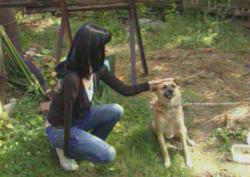 Tatiana lost her right arm. She is caressing a dog with her left hand and says she is not blaming the dogs. They are not at fault. It is humans who are responsible for dogs. At the end of her interview Tatiana said she wished Belarus had shelters for abandoned animals.
Tatiana lost her right arm. She is caressing a dog with her left hand and says she is not blaming the dogs. They are not at fault. It is humans who are responsible for dogs. At the end of her interview Tatiana said she wished Belarus had shelters for abandoned animals.
The common question of the general public: 'Why is Belarus so cruel to dogs and cats?' is followed by an answer of the officials: 'What if they attack a human?'
The dogs attacked Tatiana.
Do any of the officials listen to her? No!
На сайте: 57
Гостей сайта: 56
Пользователей: 1

Your comment